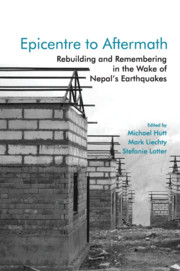7 - Policies, Politics, and Practices of Landslide Risk Management in Post-earthquake Nepal: Perspectives from Above and Below
Published online by Cambridge University Press: 08 July 2021
Summary
Introduction
When an earthquake strikes, the humanitarian response, understandably, focuses on the impacts of the immediate shaking and associated aftershocks. Comparatively less attention is given to secondary hazards including, for example, landslides, which in mountainous countries such as Nepal often present a greater and longer-term risk to the population than the shaking of the earthquake itself. Past earthquakes, including those in Kashmir in 2005 and Wenchuan in China in 2008, have shown that, in addition to the landslides caused by the initial event, mountain communities can expect an increase in landslide activity for decades or longer afterwards, with significant implications for post-disaster recovery and reconstruction. The 2015 earthquake sequence in Nepal is reported to have triggered around 22,000 landslides (Roback et al. 2018), the equivalent of decades of normal monsoon-triggered landsliding. This has resulted in fundamental changes to the landscape: some villages have been destroyed and their population permanently displaced; others are living with a new and ongoing threat of landslides and the uncertainty that this brings. In this chapter, we explore the implications of landsliding for post-earthquake reconstruction from the perspective of scientists, national and local governments, and rural residents living with evolving landslide risk. We draw on our interdisciplinary research undertaken as part of a Department for International Development/ Natural Environment Research Council (DfID/NERC)–funded Science for Humanitarian Emergencies and Resilience project which brings together different analytical and methodological perspectives, including landslide mapping based on satellite imagery, ethnographic work with rural residents, and interviews with government stakeholders and non-governmental organization (NGO) representatives supporting householders impacted by earthquake-induced geohazards. Like Nightingale (2003) in the context of forest management in rural Nepal, we seek to highlight and interrogate the partiality of the different forms of knowledge generated and the implications this has for post-disaster reconstruction and risk management.
Drawing on the work of Oven and Rigg (2015), we begin the discussion by exploring the changing spatiality of hazard, vulnerability, and risk in the earthquake-affected districts of West-Central Nepal, an area described as the ‘Tamang epicentre’ (Magar 2015), with a particular focus on the Upper Bhote Kosi Valley in Sindhupalchok district. From a landslide perspective, this valley was among the most heavily impacted by the 2015 earthquakes.
- Type
- Chapter
- Information
- Epicentre to AftermathRebuilding and Remembering in the Wake of Nepal's Earthquakes, pp. 151 - 176Publisher: Cambridge University PressPrint publication year: 2021
- 3
- Cited by



